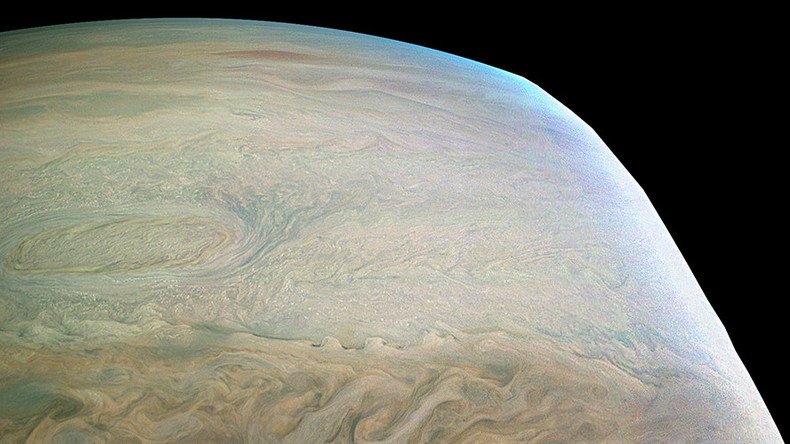Jupiter close-up: Juno snaps stunning image of planet’s swirling clouds (PHOTO)

NASA has shared an incredible close-up portrait of Jupiter taken from the Juno probe during its fifth flyby of the giant planet.
The snap was captured by the JunoCam on March 27, as the spacecraft completed its latest orbit, at a distance of about 12,400 miles (20,000km) from the massive planet.
Our @NASAJuno's camera is so close to Jupiter, it cuts off the edges or limb of the planet. Details: https://t.co/CCemIh1kKdpic.twitter.com/xU1ryWGrvr
— NASA (@NASA) April 19, 2017
Social media users were quick to comment on the unusual shape of Jupiter in the image.
@NASA@NASAJuno Proof!!! Jupiter is flat!!!!
— Vallikat (@Vallikat) April 19, 2017
@NASA@NASAJuno So, Jupiter isn't round and looks like lampworked glass? Who knew?
— Karen Petronis (@klpbirds) April 19, 2017
However, NASA explained that because the Juno spacecraft is so close to Jupiter its camera cannot capture the entire illuminated area in one image, and so the gas giant’s sides are cut off at the edges.
READ MORE: ‘Ghostlike’ Jupiter captured in latest batch of stunning NASA photos
Before this latest journey over Jupiter’s mysterious cloud tops, the public was asked to vote on picture sites for the JunoCam to target. NASA makes its raw Juno images available to the public, and said in a statement about the latest stunning release that the “enhanced color image was created by citizen scientist Bjorn Jonsson.”
The detailed photo captures several interesting features and activity on the mottled planet’s surface including areas Jupiter spotters referred to as the "String of Pearls", “Between the Pearls” and “An Interesting Band Point.”
The STB Spectre, a feature in Jupiter’s South Temperate Belt, where multiple atmospheric conditions appear to collide, is also visible in the image.
‘Galaxy of swirling storms’: Juno snaps stunning turbulence over Jupiter https://t.co/kIo35u5HBqpic.twitter.com/hP4hSev8vm
— RT (@RT_com) March 25, 2017
The $1 billion spacecraft launched in 2011 and took five years to reach Jupiter. It began orbiting the planet last July and will make its next close flyby on May 19. In February next year, the space probe will undergo the final leg of its Jupiter journey, plunging into the planet’s clouds and burning up.












